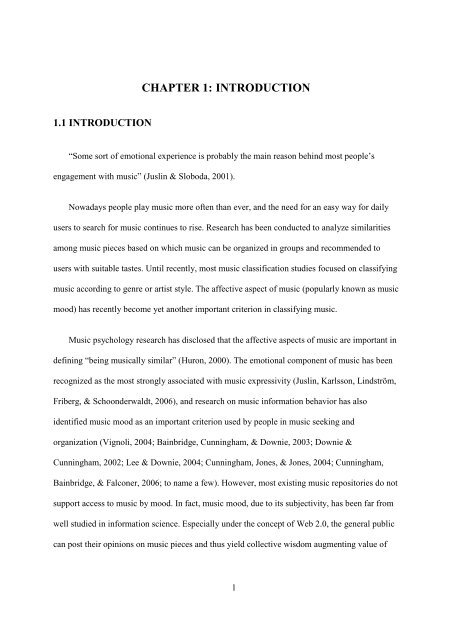improving music mood classification using lyrics, audio and social tags
improving music mood classification using lyrics, audio and social tags
improving music mood classification using lyrics, audio and social tags
You also want an ePaper? Increase the reach of your titles
YUMPU automatically turns print PDFs into web optimized ePapers that Google loves.
CHAPTER 1: INTRODUCTION<br />
1.1 INTRODUCTION<br />
“Some sort of emotional experience is probably the main reason behind most people’s<br />
engagement with <strong>music</strong>” (Juslin & Sloboda, 2001).<br />
Nowadays people play <strong>music</strong> more often than ever, <strong>and</strong> the need for an easy way for daily<br />
users to search for <strong>music</strong> continues to rise. Research has been conducted to analyze similarities<br />
among <strong>music</strong> pieces based on which <strong>music</strong> can be organized in groups <strong>and</strong> recommended to<br />
users with suitable tastes. Until recently, most <strong>music</strong> <strong>classification</strong> studies focused on classifying<br />
<strong>music</strong> according to genre or artist style. The affective aspect of <strong>music</strong> (popularly known as <strong>music</strong><br />
<strong>mood</strong>) has recently become yet another important criterion in classifying <strong>music</strong>.<br />
Music psychology research has disclosed that the affective aspects of <strong>music</strong> are important in<br />
defining “being <strong>music</strong>ally similar” (Huron, 2000). The emotional component of <strong>music</strong> has been<br />
recognized as the most strongly associated with <strong>music</strong> expressivity (Juslin, Karlsson, Lindström,<br />
Friberg, & Schoonderwaldt, 2006), <strong>and</strong> research on <strong>music</strong> information behavior has also<br />
identified <strong>music</strong> <strong>mood</strong> as an important criterion used by people in <strong>music</strong> seeking <strong>and</strong><br />
organization (Vignoli, 2004; Bainbridge, Cunningham, & Downie, 2003; Downie &<br />
Cunningham, 2002; Lee & Downie, 2004; Cunningham, Jones, & Jones, 2004; Cunningham,<br />
Bainbridge, & Falconer, 2006; to name a few). However, most existing <strong>music</strong> repositories do not<br />
support access to <strong>music</strong> by <strong>mood</strong>. In fact, <strong>music</strong> <strong>mood</strong>, due to its subjectivity, has been far from<br />
well studied in information science. Especially under the concept of Web 2.0, the general public<br />
can post their opinions on <strong>music</strong> pieces <strong>and</strong> thus yield collective wisdom augmenting value of<br />
1
















